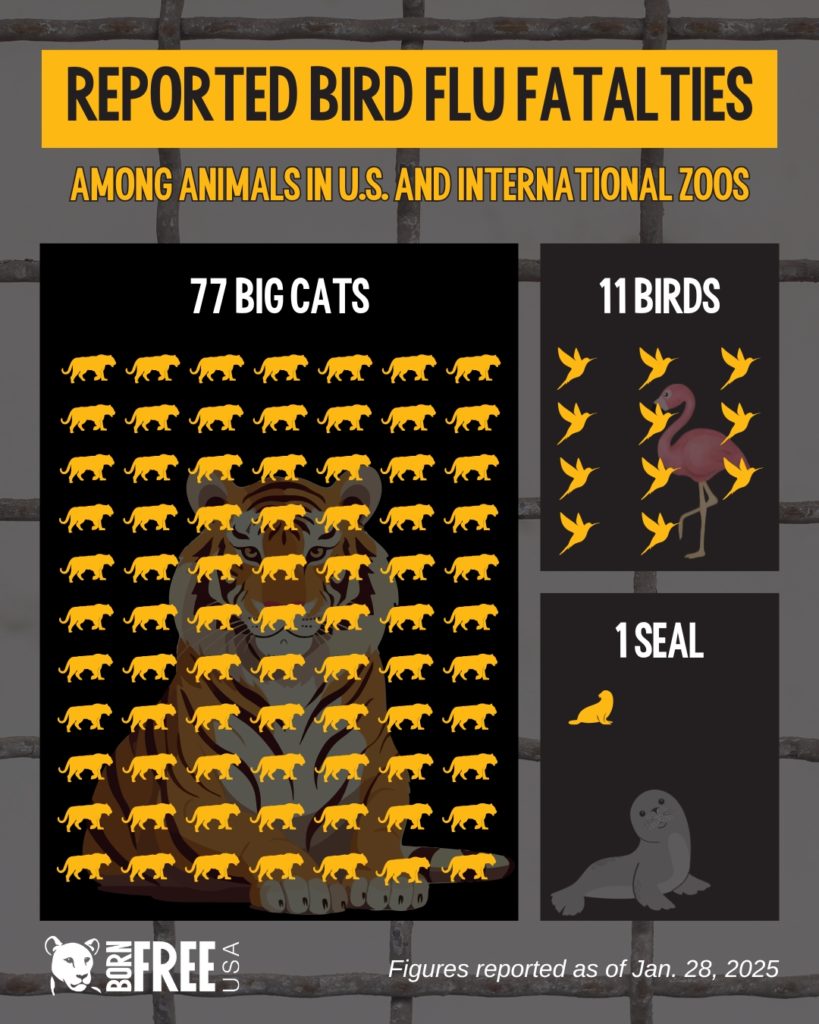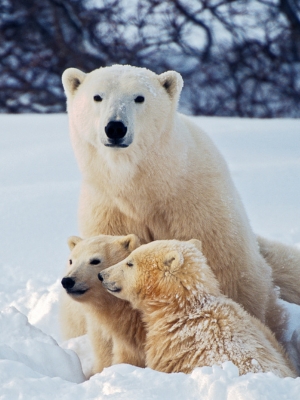Since our Risky Business: The Dangers of Zoonotic Disease in the Fur Trade report was released in August of 2024, bird flu already had a devastating impact on both birds in the wild and in captivity, affecting an estimated 96,565,226 birds around the world and leading to the slaughter of millions of birds in the poultry industry to reduce the disease spread. So far, the illness has spread from wild birds to captive poultry, dairy cattle, minks on fur farms, domestic companion animals, and wild animals. Luckily, no documented human-to-human transmission has occurred thus far.
Bird Flu Has Been Spreading among Captive Animals in the U.S. for Years
Beginning in 2022, the zoo industry was increasingly starting to experience the damaging effects of bird flu; Reid Park Zoo in Tucson, Arizona, closed its bird exhibits in 2022 after discovering the presence of bird flu in three birds, two of whom died. Additional safety measures were put in place after an infection was suspected when a king vulture named Phil suddenly died. Zoo officials speculated that transmission occurred via wild birds like ducks and geese freely roaming the zoo grounds.
By 2025, more wild animals in captivity have been infected with bird flu than ever before. In December of 2024, in Shelton, Washington state, 20 big cats died after contracting bird flu at an unaccredited animal “sanctuary” called the Wild Felid Advocacy Center of Washington, including four cougars and a Bengal tiger hybrid. According to National Public Radio (NPR), the sanctuary said the outbreak may have been caused by respiratory secretions passed from infected birds to the cats or by contaminated meat fed to the cats. The facility also stated that bird flu poses a serious risk to felines, often progressing from mild symptoms to fatal pneumonia within 24 hours.
After the first cougar died in November, the disease quickly spread. Concerningly, while some of the cats shared a wall between their habitats, they did not have direct contact with each other. In early December, California Governor Gavin Newsom declared a state of emergency due to the rampant spread of bird flu among dairy cattle and the increasingly reported outbreaks in wild and domestic bird populations across the country.
Five animals died from bird flu at the Wildlife World Zoo and Aquarium in Litchfield Park, Arizona, in December 2024, including a cheetah, mountain lion, swamphen, kookaburra, and Indian goose. A white tiger also tested positive for bird flu but responded well to treatment.
The San Francisco Zoo in California temporarily closed its indoor bird exhibits after a wild red-shouldered hawk who lived on the zoo grounds died and tested positive for bird flu. In November, Seattle’s Woodland Park Zoo in Washington state reported the death of a red-breasted goose who tested positive for highly pathogenic avian influenza (HPAI), an even more contagious strain of bird flu. The zoo stated that it would implement “additional health and safety precautions” to protect its birds, staff, and visitors, though the efficacy of these procedures has yet to be determined.
In January 2025 in Chicago, Illinois, at the Lincoln Park Zoo, a 7-year-old harbor seal named Slater and several month-old Chilean flamingo named Teal also died from a bird flu outbreak. The zoo stated that their bird house will be closed for an undetermined period of time to protect the other animals. The zoo’s statement explained that it had not yet confirmed how either of the animals had been exposed to bird flu. However, “it is near certain the cause is from contact with a waterfowl infected with HPAI.” On January 16th, officials at the Metro Richmond Zoo in Virginia confirmed that two cranes tested positive and died from the virus as well.
Captive Animals Outside of the U.S. Have Also Been Impacted by Bird Flu
The spread of bird flu has also affected wild animals kept in captivity overseas outside of the United States. The deaths of 47 tigers, three lions, and a panther were reported at zoos in South Vietnam at the Vuon Xoai Zoo near Ho Chi Minh City and the My Quynh Safari Park in the nearby Long An province in October 2024. The animals had likely fallen ill after being fed meat from chickens who had been infected. In late December 2024, three tigers and one leopard died from bird flu at the Gorewada Rescue Centre in Nagpur, India. The animals were transported to the rescue center from Chandrapur after human-wildlife conflict occurred in their natural habitat in December. They started showing symptoms of bird flu within one week of arrival.

The Idea that Wild Animals are “Safer” in Captivity is a Myth
Despite the common belief that animals are “safer” in zoos, animals can be more susceptible to diseases and are more likely to die from them in captivity than their counterparts in the wild. In addition to contracting bird flu, the confined nature, high stress level, limited opportunity for physical activity, decreased access to sunlight/good air flow, inability to engage in species-specific behaviors, minimal ability to build up a strong immune system, increased level of exposure to numerous species with whom animals in zoos did not co-evolve, and increased chance of encountering infected materials via contact with other animals’ waste, contaminated surfaces, or zoo keepers, wild animals in captivity are extremely prone to contracting infections from a wide range of sources. For example, captive elephants have higher mortality rates from Elephant endotheliotropic herpesvirus-hemorrhagic disease (EEHV-HD) than free-living elephants. Zoos with active breeding and transfer programs have seen particularly high rates of offspring loss from EEHV. Captive-born carnivores are more likely to get sick and die from viruses and diseases than wild-bred carnivores, including reproductive disorders and pathogens passed from contaminated raw meat. Infectious diseases are also a common cause of death for animals in zoos, including salmonella, tuberculosis, and anthrax.
The First Severe Human Case of Bird Flu Was Recently Confirmed
In late December 2024, the Centers for Disease Control and Prevention (CDC) confirmed the first severe human case of bird flu in the U.S.: a Louisiana resident who was hospitalized and then died in January 2025 after being exposed to a combination of non-commercial backyard flocks and wild birds. According to CDC, there have been 66 human cases of bird flu confirmed in a total of 10 states.
California has the most cases with 37, followed by Washington with 11, and Colorado with 10. California is the top-producing dairy state in the U.S., and nearly half of the state’s 1,300 farms have now been affected by bird flu. State health officials say the best way for families to protect themselves from bird flu is to avoid sources of exposure, like direct contact with wild birds or other animals that might be infected.
Most recently, on Monday January 20, 2025, British health authorities announced that they confirmed a bird flu case in a human in central England, though the risk to the wider public remains “very low.” The person acquired the infection on a farm, where they had direct and extended contact with many infected birds. They are reportedly doing well and responding to treatment. British authorities continue to take steps to quell the disease spread, including by culling large numbers of animals.
Could Bird Flu Become the Next Pandemic Illness?
As bird flu continues to spread, the possibility of another pandemic becomes more eminent. In addition to the growing threat of disease transmission to humans, bird flu also presents another obstacle for wild animal species in captivity already threatened with extinction in the wild. Zoos are clearly not able to protect these animals from highly contagious and potentially fatal diseases like bird flu, as their very existence requires high densities of animals to be kept in small spaces, in close quarters, just waiting until they contract one final disease that will end it all. The worst part? Researchers have warned for decades that this variant of bird flu could kill primates, rodents, pigs, rabbits, and other animals. If the deaths of the animals that zoos claim so fervently to protect will not convince zoos of the risks of keeping wild animals captive, what will?
Keep Wildlife in the Wild,
Devan
Dear Reader,
We are a nonprofit committed to wildlife conservation, welfare, and rescue. Making resources free and widely distributed, like our news items, is an important part of our mission. If you found this article helpful, enjoyable, or enlightening, please donate to help keep these resources available, and Keep Wildlife In The Wild.
Thank You,
The Born Free USA Team

 Dear Reader,
Dear Reader,